UK Road Signs
Guide to UK Road Signs
This guide is designed to help you understand the different types of road signs that you’ll see on UK roads and what they mean.
For more information on the laws behind the signs, you might also find this guide to UK road laws interesting. You can see a full breakdown of all road signs and their meanings on the government's website here.
There are 3 styles of signs you'll encounter, and these are:
- Circular signs
- Triangular signs
- Rectangular signs
Each of these has a distinct function and the different shapes are designed so that you can easily tell what type of information the sign provides.
Typically, circular signs are instructions, triangular signs are warnings and rectangular signs are informative ones.
Circular signs
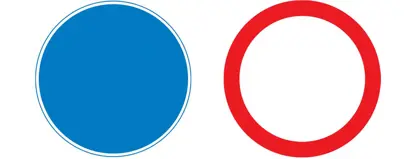
Circular signs give orders.
There are a few kinds that you'll see on the road.
A circular sign with a white background and then a red outline like the image above on the right will be an order not to do something.
A blue circle, like the left one, gives mandatory instructions that you must follow, for example turn left, or indicates a route available to only some road users like buses or bicycles.
Speed limits
Speed limits are usually shown on a white circle with a red border around the edge. In this case, these are the maximum speeds you're legally allowed to travel along this road although it might not always be possible or safe to travel at this speed and you mustn't exceed the limit.
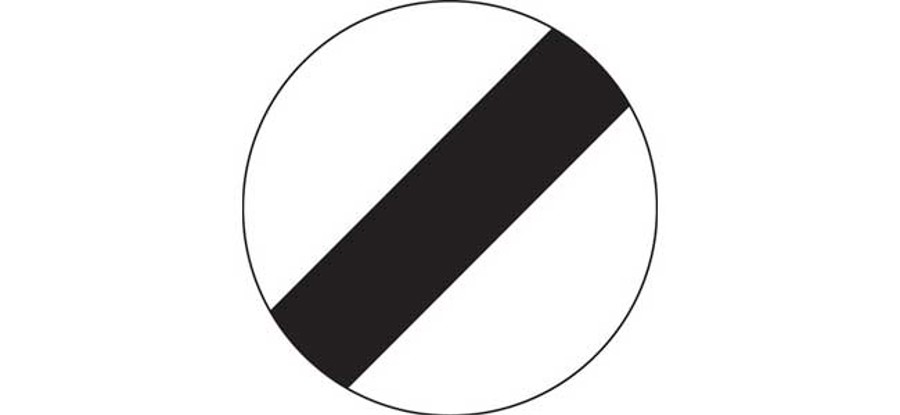
You might also see a national speed limit sign. This is a white circle with a diagonal black line through it, like the one shown on the left.
The national speed limit will vary depending on the type of road you're driving on.
If it's in a built-up area then it will be 30 mph, in a non-built-up area it'll be 60 mph, unless you're on a dual carriageway or motorway where it'll be 70 mph.
It's rare that you'll see this sign used in a built-up area. It'll usually only be used in a non-built-up area to mark a speed limit of 60 or 70 mph, where it's easy to tell the difference based on the number of lanes.
There are some occasions where a speed limit might be shown in a rectangular sign. This is usually when showing a change in limit alongside another factor you should be aware of. One example of this is where speed limits are shown alongside a sign advising you are nearing a school and they are combined on one sign. There will still be a circle with the limit inside it, but this will be part of a larger rectangular sign.
Although they're rarer, you might also find a minimum speed limit sign. It’s not often that these are used and when they are it's usually in places where it's dangerous for you and others to be driving slowly, for example in a tunnel where exposed to fumes.
These have a blue background, so you know they're a minimum and not a maximum limit.
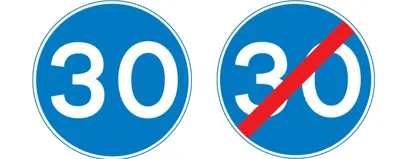
The left picture is what you'll see at the start of a minimum speed limit and the right one is the one you'll see at the end of the minimum speed limit.
Triangular signs
Triangular signs are used to warn you of an upcoming danger.
There are a number of different signs you’ll see, including several that highlight the different kinds of animals that could appear on that stretch of road.
Other warnings include: narrowing roads, merging traffic, junctions, roundabouts, humps and many more.

The triangle usually appears like the one on the right, with one narrow point at the top and a wider base.
However, there are a couple of exceptions where it'll be the other way around with the wider part at the top and the point at the bottom. This is usually used on a give way sign or one warning of an upcoming junction where you'll need to give way. The reason the triangle is inverted for this sign is to make it stand out.
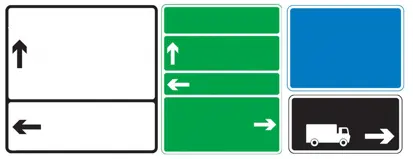
Rectangular signs
Rectangular signs are usually used to communicate information to you.
They can provide you with information on the roadside with distances and directions to specific places, information on upcoming services, restrictions and much more .
There are 3 main colours these signs will be: blue, green and white.
Occasionally you'll also see a black sign like the one above which is the advisory route for lorries if there are weight, width or height restrictions on other routes.
White signs are used on minor roads and green signs will be used on primary roads; both will provide you with directional information usually.
Blue signs are used for 2 purposes. One is on motorways for directions as well as information. The other is to provide information for road users in built-up areas.
Some examples of these informative signs can be seen below.
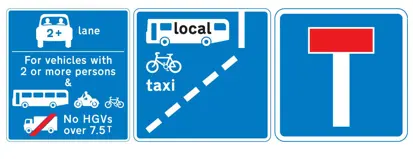
Tourism road signs
Another kind of road sign you might encounter is a brown directional or rectangular one.
The brown colour is used for tourist attractions and there are a number of different ones that you’ll see on the roads around the UK. Below are some of the most common pictures you can expect to see:
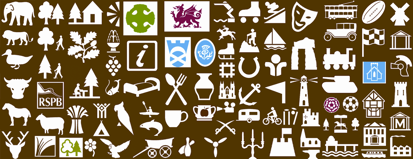
Although these are the most common, some are more popular than others and you might not recognise all of the images.
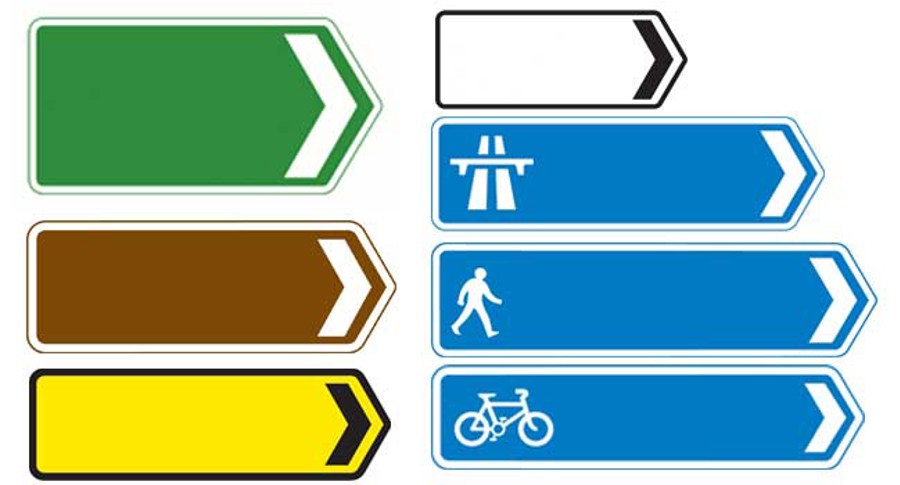
Directional signs
Directional signs might also have an arrow point like the ones shown on the right.
Again, white signs are used on minor roads, green signs are used on primary roads and blue signs are used on motorways.
Blue is also used in built up areas to mark pedestrian or cycle routes. As you can see from the images, these are usually marked by a bicycle or walker on the sign as well.
You should be able to tell who the blue signs are for based on where they're used, as bicycles and pedestrians aren't allowed on motorways, for example.
Temporary road signs
Yellow road signs are used for temporary routes or in an area where there are road works.
The below image shows the signs used for diverted routes. The different shapes are used to mark different routes, as there can commonly be more than one diversion in place when a main road is shut.
Directional arrows may also be used.

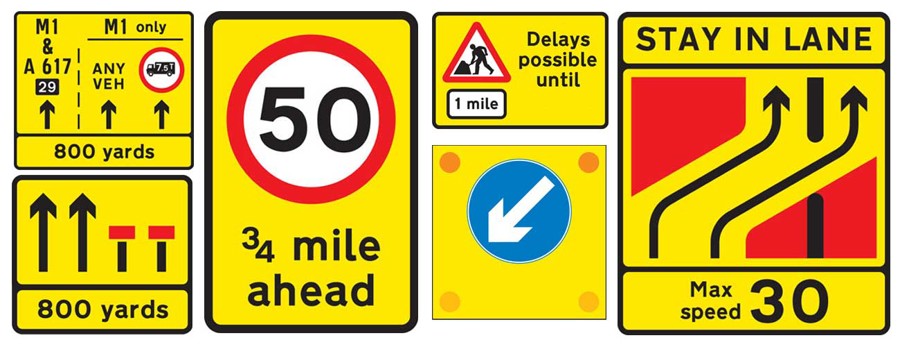
Where there are road works, a number of different instructions might be given but some of the most common are shown below.
Other road signs
There are a few exceptions to the rules mentioned above and one of these is the stop sign.
This is the only sign that you'll see in a red hexagon shape so that it stands out for all drivers and you must stop when you see this sign.
Other signs you might see include the ones below that provide further and specific information. The one in the centre is the sign you’ll see when entering an area with a school crossing patrol, and the one on the right tells you there are speed cameras on the road ahead.
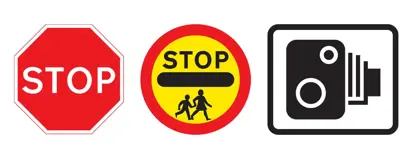
If you’d like to learn more about driving laws in the UK then take a look at this guide or head back to our guide’s homepage to see our other guides.